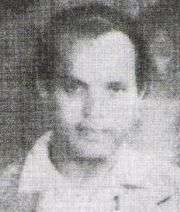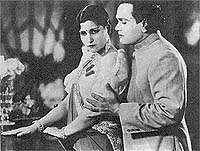P. K. Raja Sandow
| Raja Sandow | |
|---|---|
 | |
| Born |
1894 or 1895 Pudukottai, India |
| Died | 1943 (aged 48–49) |
| Occupation |
Film director, film producer, Actor |
| Years active | 1923–1943 |
Raja Sandow (1894[1]-1943) (born as P.K. Nagalingam) was a Tamil film actor, film director and producer.[2] He began his career as an actor in silent films and later became a prominent actor and director in Tamil and Hindi films of the 1930s. He is considered to be one of the pioneers of early Indian cinema.[3][4][5][6]
Biography and career
Raja Sandow was born in Pudukottai, Tamil Nadu.[7] He was trained as a gymnast and started his film career as a stunt actor in S.N. Patankar's National Film Company at Bombay.[8] He was given the name "Raja Sandow" because of his physique (after strongman Eugen Sandow).[9] His first lead role was in Patankar's Bhaktha Bhodhana (1922), for which he was paid Rs. 101 as salary.[10] He became famous by starring in silient films like Veer Bhemsen (1923), The Telephone Girl (1926).[11] After acting in a few silent films he also worked as a director in Ranjit Studios for a monthly salary.[2] His first film as director was Sneh Jyoti (1928).[12]
Returning to Tamil Nadu, he directed and acted in a number of silent films for R. Padmanaban's Associate Film Company.[2] Many of his silent films had reformist social themes like Peyum pennum (1930), Nandhanar (1930), Anadhai Penn (1931), Pride of Hindustan (1931) and sathi usha sundari (1931).[13] After talking films were introduced with Alam Ara in 1931, he went back to Bombay and starred in many Hindi and Tamil talkies. He was often paired with the actresses Gohar and Sulochana (Ruby Myers).[2][9] Between 1932–35, he acted in many socially themed Hindi films like Shyam sundar (1932), Devaki (1934) and Indira MA (1935). In 1935, he was commissioned to direct his first Tamil film Menaka and returned to Madras. He continued directing and acting in films till his death in 1943. Vasantha Sena(1936), Chalak Chor (1936), Chandra kantha (1936), Vishnuleela (1938), Thiruneelakantar (1939) and Choodamani (1941) were some of the films he directed and starred in during that period. The last film he worked in was Sivakavi (1943).
Sandow suffered a heart attack and died at Coimbatore on 25 November 1943.[14]
Legacy

Sandow was the first Tamil film director to adopt the practice of using names of actors in film titles. He was the first to introduce intimate kissing scenes and dancers in revealing costumes to the then conservative Tamil film industry.[15][16] He was also the first director and producer to move Tamil cinema from remaking mythological stories and into making social themed films. He even advertised his films as "Don't miss to see your own picture".[17] Sandow was also the first director to use Tamil literary works for film by directing Anadhai penn in 1931 based on Vai. Mu. Kothainayagi Ammal's novel of the same name.[14]
Writing about Sandow, film historian Theodore Baskaran says:
| “ | As a director, actor, scriptwriter and producer, his contribution to Tamil cinema is significant. Many of the stars of the Forties and Fifties have worked with him. He was very competent at coaching actors and maintained complete control over his films. He was a martinet on the sets and was often compared to a ringmaster in a circus. In his films, the emphasis shifted from songs to the spoken word.[2] | ” |
Film historian Randor Guy has also described him as a tough task master:
| “ | Raja Sandow was a tough and no-nonsense guy who would not hesitate to shout at and slap his crew and cast including women! Regretfully there are no such directors these days!.[16] | ” |
The Tamil Nadu Government has instituted an annual award in his name called Raja Sandow memorial Award, given for outstanding services to Tamil Cinema.[18] A Postage stamp has been in issued in recognition of his contributions to Indian cinema.[19]
Filmography
| Year | Film | Language | Credits |
|---|---|---|---|
| 1922 | Bhaktha Bhodhana | Silent film | Actor |
| 1922 | Karna | Silent film | Actor |
| 1922 | Suryakumari | Silent film | Actor |
| 1923 | Veer Bhimsen | Silent film | Actor |
| 1923 | Vratrasoor Vadha | Silent film | Actor |
| 1924 | Ra Mandlik | Silent film | Actor |
| 1924 | Bismi Sadi | Silent film | Actor |
| 1924 | Razia Begum | Silent film | Actor |
| 1924 | Sadguni Sushila | Silent film | Actor |
| 1924 | Sati Sone | Silent film | Actor |
| 1925 | Deshna Dushman (The Divine Punishment) | Silent film | Actor |
| 1925 | Deva dasi | Silent film | Actor |
| 1925 | Indrasabha | Silent film | Actor |
| 1925 | Kala Chor(The Black Thief) | Silent film | Actor |
| 1925 | Khandani Khavis(The Noble Scamp) | Silent film | Actor |
| 1925 | Matri Prem(For Mother's Sake) | Silent film | Actor |
| 1925 | Mojili Mumbai(Slaves of Luxury) | Silent film | Actor |
| 1925 | Panchdanda(Five Divine Wands) | Silent film | Actor |
| 1925 | Raja Yogi | Silent film | Actor |
| 1925 | Suvarna | Silent film | Actor |
| 1925 | Veer Kunal | Silent film | Actor |
| 1925 | Vimala | Silent film | Actor |
| 1926 | Madhav Kam Kundala | Silent film | Actor |
| 1926 | Mena Kumari | Silent film | Actor |
| 1926 | Muntaz Mahal | Silent film | Actor |
| 1926 | Neerajanam | Silent film | Actor |
| 1926 | Prithvi Putra | Silent film | Actor |
| 1926 | Ra Kawat | Silent film | Actor |
| 1926 | Samrat Shiladitya | Silent film | Actor |
| 1926 | Telephone Girl | Silent film | Actor |
| 1926 | Typist Girl | Silent film | Actor |
| 1927 | Bhaneli Bhamini | Silent film | Actor |
| 1927 | Sati Madri | Silent film | Actor |
| 1927 | Sindh Ni Sumari | Silent film | Actor |
| 1927 | The Mission Girl | Silent film | Actor |
| 1927 | Aladdin Aur Jadui Chirag(Aladdin & the Wonderful Lamp) | Silent film | Actor |
| 1928 | Grihalakshmi | Silent film | Actor |
| 1928 | Naag Padmini | Silent film | Actor |
| 1928 | Sneh Jyoti | Silent film | Actor, director |
| 1928 | Up-to-date | Silent film | Actor |
| 1928 | Vishwamohini | Silent film | Actor |
| 1929 | Young India | Silent film | Actor |
| 1929 | Young India | Silent film | Actor |
| 1930 | Bhimsen The Mighty | Silent film | Actor |
| 1930 | Peyum pennum | Silent film | Actor, director |
| 1930 | Rajlakshmi | Silent film | Actor |
| 1930 | Nandhanar (Elevation of the Downtrodden) | Silent film | Actor, director |
| 1930 | Sri Valli Thirumanam | Silent film | Actor, director |
| 1930 | Anadhai penn | Silent film | Actor, director |
| 1931 | Taranhar (Pride of Hindustan) | Silent film | Actor, director |
| 1931 | Sati Usha Sundari | Silent film | Director |
| 1931 | Rajeshwari | Silent film | Director |
| 1931 | Bhaktavatsala (Dhuruvanin Garvabangam) | Silent film | Director |
| 1932 | Parijaatha pushpaharanam | Tamil | Director |
| 1932 | Shyam sundar | Hindi | Actor |
| 1933 | Pardesi Preetam | Hindi | Actor |
| 1933 | Noor-E-Imaan | Hindi | Actor |
| 1934 | Devaki | Hindi | Actor |
| 1934 | Kashmeera | Hindi | Actor |
| 1934 | Toofani Taruni | Hindi | Actor |
| 1934 | Indira M.A | Hindi | Actor |
| 1935 | Toofani Taruni | Hindi | Actor |
| 1935 | Raat-Ki-Rani | Hindi | Actor, director |
| 1935 | Barrister's wife | Hindi | Actor |
| 1935 | College Kanya | Hindi | Actor |
| 1935 | Desh Dasi | Hindi | Actor |
| 1935 | Menaka | Tamil | Director |
| 1936 | Prabhu Ka Pyara | Hindi | Actor |
| 1936 | Vasantha Sena | Tamil | Actor, director |
| 1936 | Vasantha Sena | Tamil | Actor, director |
| 1936 | Chalak Chor | Hindi | Actor, director |
| 1936 | Chandrakantha | Tamil | Scriptwriter, director |
| 1936 | Dil ka Daku | Hindi | Actor |
| 1936 | Matlabi Duniya | Hindi | Actor |
| 1937 | Toofani Tarzan | Hindi | Actor |
| 1937 | Minor Rajamani | Tamil | Director |
| 1938 | Nandha Kumar | Tamil | Actor |
| 1938 | Vishnuleela | Tamil | Actor, director |
| 1939 | Thiruneelakantar | Tamil | Actor |
| 1941 | Choodamani | Telugu | Director |
| 1942 | Araichimani | Tamil | Director |
| 1943 | Sivakavi | Tamil | Director (replaced halfway) |
References
- ↑ Theodore Baskaran in his The eye of the serpent gives 1894 as the year of birth for Sandow. Randor Guy says he was born in 1895.
- 1 2 3 4 5 Baskaran, S. Theodore (1996). The eye of the serpent: an introduction to Tamil cinema. Chennai: East West Books. p. 194.
- ↑ Mylapore and movies, The Hindu 18 October 2001
- ↑ Trendsetter from www.screenindia.com
- ↑ Velayutham, Selvaraj (2008). Tamil cinema: the cultural politics of India's other film industry (Hardback ed.). New York: Routledge. p. 3. ISBN 978-0-415-39680-6.
- ↑ Blazing new trails, The Hindu 2 May 2004
- ↑ Baliga, B.S (1957). Madras District Gazetteers: Pudukkottai. Chennai: Superintendent, Govt. Press. p. 274.
- ↑ Cinema vision India, Volume 1 Issue 1. Chennai. 1980. p. 37.
- 1 2 Majumdar, Neepa (2009). Wanted Cultured Ladies Only!: Female Stardom and Cinema in India, 1930s–1950s. University of Illinois Press. pp. 111–2. ISBN 0-252-07628-1, ISBN 978-0-252-07628-2.
- ↑ Randor Guy (20 August 2010). "A man with a vision". The Hindu. Retrieved 20 August 2010.
- ↑ Majumdar, Neepa (2009). Wanted Cultured Ladies Only!: Female Stardom and Cinema in India, 1930s–1950s. University of Illinois Press. p. 98. ISBN 0-252-07628-1, ISBN 978-0-252-07628-2.
- ↑ Chabria, Suresh (1994). Light of Asia: Indian silent cinema, 1912–1934. Wiley Eastern. p. 138. ISBN 81-224-0680-7, ISBN 978-81-224-0680-1.
- ↑ Baskaran, S Theodore (2004). Em Thamizhar Seidha Padam (in Tamil) (Paperback ed.). Chennai: Uyirmmai Padippagam. pp. 46–50. ISBN 81-88641-29-4.
- 1 2 Baskaran, S Theodore (2004). Em Thamizhar Seidha Padam (in Tamil) (Paperback ed.). Chennai: Uyirmmai Padippagam. pp. 35–36. ISBN 81-88641-29-4.
- ↑ Blast from the past (Menaka 1935), The Hindu, 4 January 2008
- 1 2 From silents to sivaji ganesan
- ↑ Journal of Tamil studies, Issues 8–13. International Institute of Tamil Studies. 1975. p. 41.
- ↑ The stamp of honour, The Hindu 10 July 2000
- ↑ Indianstampghar.com